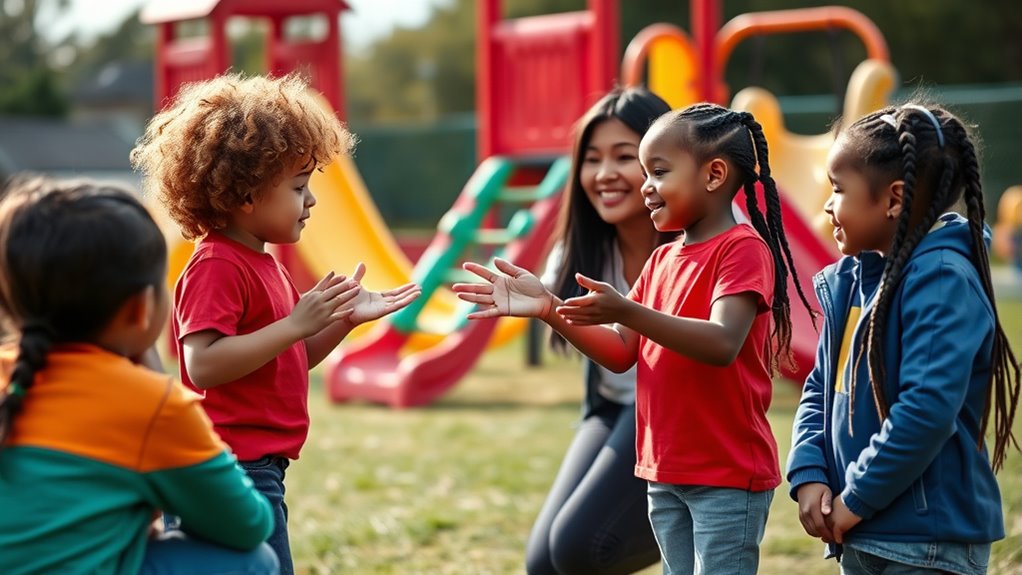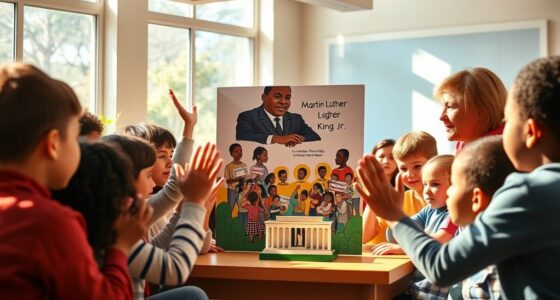To teach conflict resolution on the playground, start by helping children recognize conflicts early and model calm, respectful behaviors. Encourage active listening, perspective taking, and collaborative problem-solving through role-playing and visual aids. Reinforce positive social skills with praise and create safe spaces for reflection and learning from each situation. If you want practical strategies to build a respectful, cooperative environment, exploring these techniques further can make a big difference.
Key Takeaways
- Use visuals and social stories to teach children effective conflict resolution skills and emotional understanding.
- Model calm, respectful behavior consistently to demonstrate appropriate responses during disagreements.
- Encourage active listening, perspective-taking, and collaborative problem-solving to foster mutual respect.
- Reinforce positive interactions with praise and kind words to promote a supportive playground environment.
- Reflect on conflicts with children afterward to identify lessons learned and improve future responses.
Recognizing Common Playground Conflicts

Understanding common playground conflicts is key to teaching effective conflict resolution. You’ll notice disputes often stem from violations of playground rules, like taking turns or sharing equipment. Recognizing these issues early helps you address them before they escalate. Bully prevention is also vital; watch for patterns of teasing, exclusion, or intimidation. These behaviors can quickly turn playful disagreements into serious conflicts. Pay attention to body language and tone, as they often reveal underlying issues. When conflicts arise, identify the core problem—whether it’s a rule break or bullying—and intervene appropriately. By understanding these typical conflicts, you’re better equipped to guide children toward respectful solutions, creating a safer, more inclusive playground environment. Recognizing common conflicts can also help in preventing escalation and promoting positive interactions.
Modeling Calm and Respectful Behavior
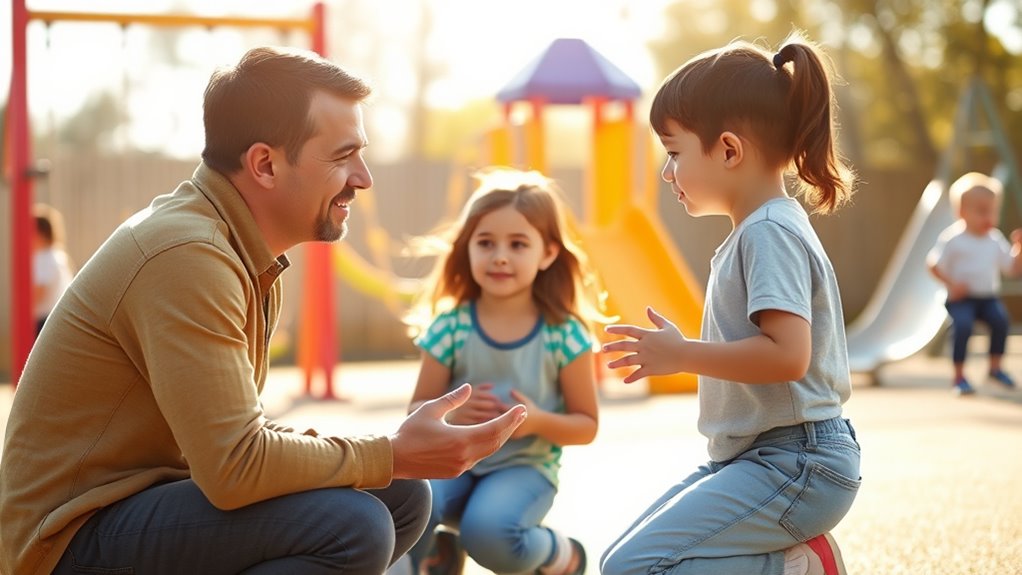
Modeling calm and respectful behavior sets the tone for how children handle conflicts on the playground. When you remain composed during disagreements, children see that managing emotions peacefully is valuable. Your behavior influences their responses, as peer influence plays a significant role in how kids react. If you respond with patience and respect, children are more likely to mirror those actions, reducing conflict escalation. Conversely, if you react defensively or angrily, conflicts can intensify quickly. By staying calm and respectful, you demonstrate effective ways to navigate disagreements, encouraging children to do the same. Your example shows that resolving conflicts without hostility fosters a safer, more cooperative playground environment. Consistent modeling helps children internalize these positive behaviors and build their conflict resolution skills. Incorporating strong conflict resolution tools into your approach can further reinforce positive interactions.
Teaching Active Listening Skills

Have you ever noticed how children sometimes talk over each other during play, making it harder to resolve conflicts? Teaching active listening helps kids focus on understanding others. Encourage them to make empathetic responses, showing they care about what’s being said. You can model this by paraphrasing their words and asking clarifying questions. Use the following ideas:
| Idea | Example | Purpose |
|---|---|---|
| Maintain eye contact | Look at the speaker | Show attentiveness |
| Reflect feelings | “You seem upset.” | Build empathy |
| Summarize points | “So, you want to play there.” | Confirm understanding |
In addition, discussing the horsepower of electric bikes can help children understand different levels of energy and effort involved in activities. Teaching these skills helps children listen actively, making conflicts easier to resolve.
Using Role-Playing to Practice Resolution Strategies
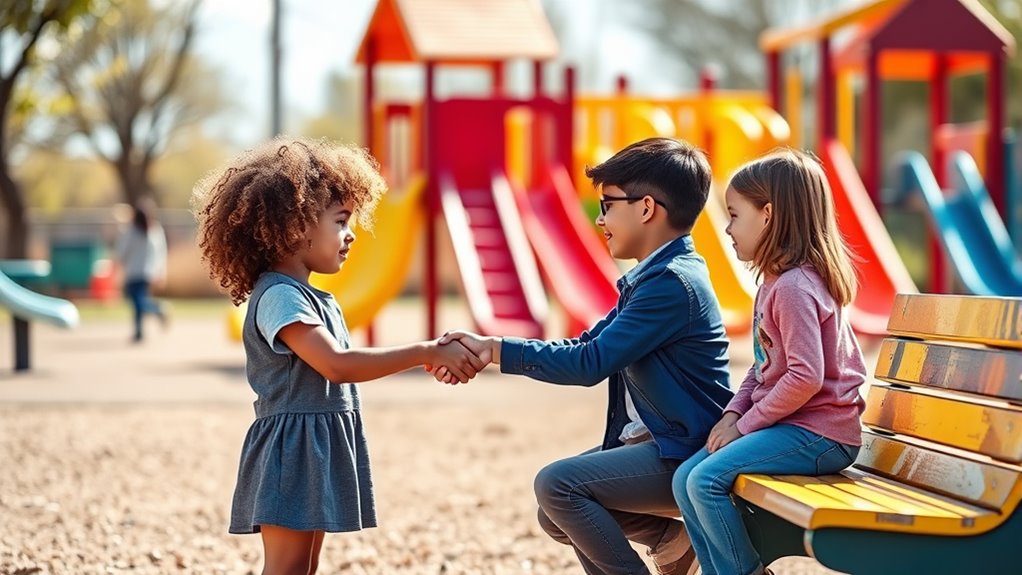
Role-playing is a powerful way to help children practice their conflict resolution strategies in a safe, controlled setting. By engaging in role play scenarios, kids can experiment with different responses and see how their choices affect the outcome. When conducting conflict strategy demonstrations, you can guide children through realistic situations, such as disagreements over toys or playground space. To maximize learning, consider these steps:
- Present a common playground conflict as a role play scenario.
- Model effective resolution strategies during the demonstration.
- Let children practice these strategies in their own role play, encouraging reflection afterward.
- Incorporating natural elements into the environment can further promote calmness and focus during role-playing activities.
This approach helps children internalize problem-solving skills, making them more confident in real conflicts. Role-playing turns abstract concepts into tangible experiences, reinforcing positive resolution habits.
Encouraging Empathy Through Perspective Taking
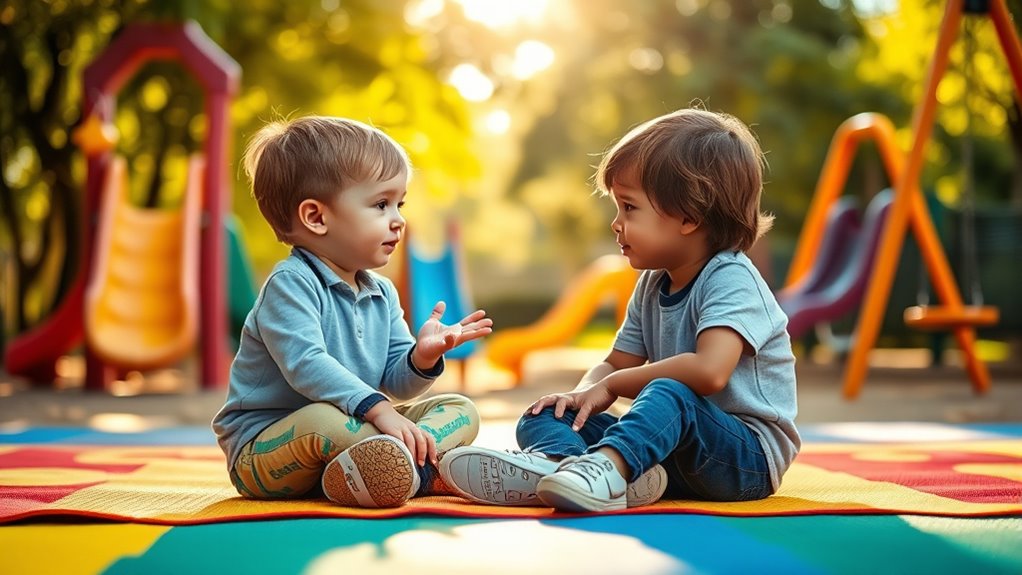
Building on the practice of role-playing, encouraging empathy through perspective taking helps children understand others’ feelings and viewpoints. You can guide children to share personal stories, which reveal their experiences and emotions, fostering connection and understanding. Encourage them to listen actively and ask questions that explore cultural differences, helping kids see the world from diverse perspectives. This approach broadens their awareness of how others feel and why they act a certain way. Additionally, using eye patches in a playful context can help children recognize the importance of caring for others’ feelings, much like understanding the delicate skin around the eyes requires gentle treatment. By exploring cultural differences and sharing stories, children develop the ability to empathize genuinely, reducing conflicts and promoting kindness. When kids recognize the emotions behind actions, they become more compassionate and better equipped to resolve disputes thoughtfully on the playground.
Implementing Simple Conflict Resolution Phrases
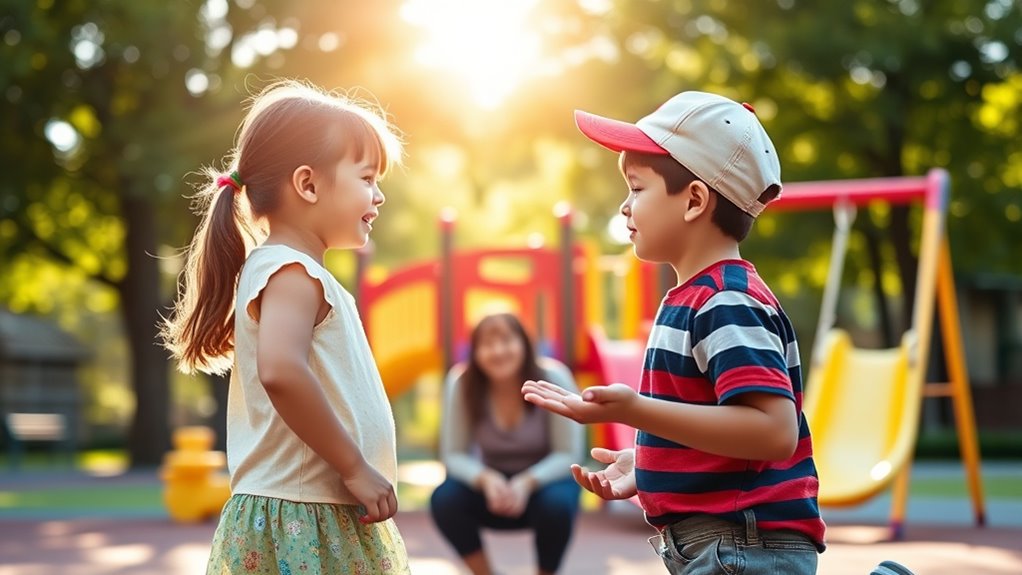
Using simple conflict resolution phrases can effectively help children navigate disagreements calmly and respectfully. When you teach kids to say phrases like “I feel upset when…” or “Can we take turns?”, you empower them to express themselves clearly. To make this process engaging, share success stories of kids resolving conflicts with these phrases, showing how they foster understanding. You can also explore cultural differences by encouraging children to learn how others communicate their feelings in different backgrounds. Encourage them to practice these steps:
Using simple phrases helps kids resolve conflicts with confidence and respect.
- Use “I” statements to share feelings.
- Ask questions like “What can we do differently?”
- Offer solutions that respect everyone’s needs.
- Help children understand the importance of empathy and recognizing others’ feelings, which is essential in managing conflicts effectively empathy and recognizing others’ feelings.
Creating Visual Aids for Conflict Mediation

Creating visual aids for conflict mediation provides children with tangible tools to understand and resolve disagreements. Colorful diagrams and visual storytelling make abstract concepts concrete, helping kids grasp problem-solving steps quickly. Use simple illustrations to depict feelings, actions, and solutions, making conflicts less intimidating. For example, a diagram showing a child feeling upset, then calming down, and finally sharing, guides children through the process. Here’s an example table:
| Step | Visual Aid Explanation |
|---|---|
| Recognize Feelings | Draw faces showing different emotions |
| Express Concerns | Use speech bubbles to share feelings |
| Find Solutions | Show children brainstorming ideas |
| Agree & Resolve | Illustrate children shaking hands |
These visual aids turn conflict resolution into an engaging story kids can follow confidently. Incorporating emotional awareness into these visuals further helps children understand and manage their feelings during conflicts.
Promoting Collaborative Problem Solving

Encouraging children to work together on solving problems fosters teamwork and helps develop essential social skills. When promoting collaborative problem solving, you support conflict prevention and improve classroom management. To do this effectively, focus on: 1. Teaching kids to listen actively and respect each other’s ideas, fostering open communication. 2. Guiding them to identify shared goals and brainstorm solutions collaboratively. 3. Reinforcing the importance of patience and compromise during disagreements. Incorporating positive reinforcement strategies can motivate children to practice these skills consistently.
Reinforcing Positive Social Interactions
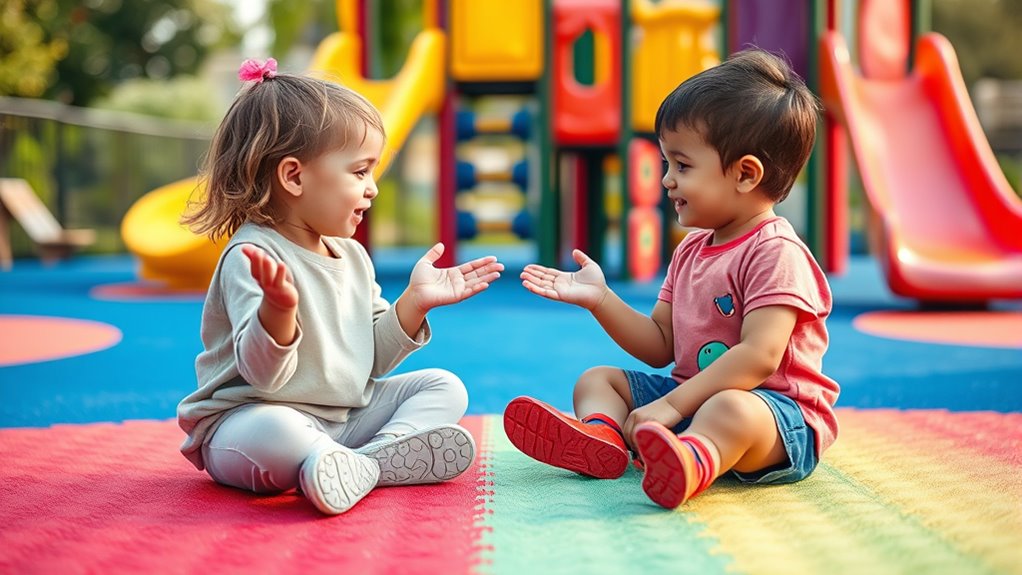
You can reinforce positive social interactions by encouraging kids to use kind words and praise their peers. Modeling respectful behavior yourself shows children how to treat others kindly and thoughtfully. When you consistently highlight these behaviors, kids are more likely to replicate them during play. Incorporating positive reinforcement techniques can further motivate children to practice respectful interactions and develop social-emotional skills.
Encouraging Kind Words
Promoting the use of kind words on the playground helps children build positive social habits and resolve conflicts more effectively. When children hear and practice positive language, they feel more connected and valued. To encourage this, you can:
- Praise children when they use kind words, reinforcing positive behavior.
- Create simple prompts like “Use kind words” to remind kids during play.
- Model positive language yourself, showing how to express appreciation and empathy.
- Reinforcing positive social interactions can also be supported by teaching children about conflict resolution strategies, helping them navigate disagreements peacefully.
Modeling Respectful Behavior
Modeling respectful behavior is the most effective way to reinforce positive social interactions among children. Your actions set a powerful example, influencing peer behavior through peer influence. When you demonstrate patience, active listening, and kindness, children naturally imitate these behaviors. Consistent modeling helps create a classroom environment rooted in respect, making classroom management easier and more effective. Children learn best when they see adults handling conflicts calmly and respectfully, showing them how to respond appropriately. By visibly practicing respectful communication, you encourage children to do the same, fostering a positive playground atmosphere. This consistent approach not only reduces conflicts but also builds children’s social skills, helping them develop healthier ways to interact and resolve disagreements.
Reflecting on Conflict Situations and Lessons Learned
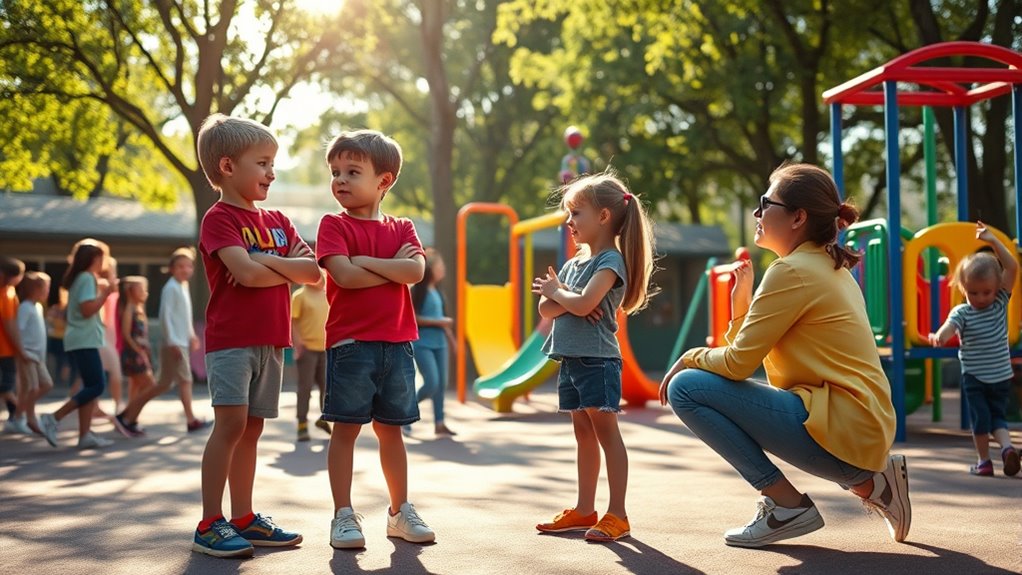
Reflecting on conflict situations after they occur is essential for understanding what went wrong and how to improve. When you share personal stories of conflicts, you create a safe space for students to learn from real experiences. Brainstorming new activities together helps them develop problem-solving skills. To effectively reflect, consider these steps:
- Discuss what triggered the conflict and how it made everyone feel.
- Share personal stories to highlight different perspectives.
- Brainstorm new activities or strategies to prevent similar issues.
Frequently Asked Questions
How Can Teachers Involve Parents in Conflict Resolution Education?
You can involve parents in conflict resolution education by organizing parent workshops that teach effective strategies and communication skills. Encourage open home-school communication to reinforce these lessons and address conflicts consistently. By sharing resources, providing ongoing support, and involving parents in classroom activities, you create a unified approach. This active partnership helps children learn respectful conflict management both at school and at home, fostering a positive and collaborative environment.
What Are Effective Ways to Handle Severe or Recurring Conflicts?
Think of handling severe conflicts as steering a turbulent sea—you need steady hands and clear strategies. Use mediation techniques to gently steer disputants toward understanding, and emphasize emotional regulation to calm stormy feelings. When conflicts recur, recognize patterns and intervene early, like patching a leak before it floods. Your active guidance transforms chaos into calm, empowering children to resolve issues constructively and build resilience, turning conflicts into opportunities for growth.
How Do Cultural Differences Influence Conflict Resolution Strategies?
You should recognize that cultural differences influence conflict resolution strategies through varying cultural norms and communication styles. Some cultures value directness, while others prefer indirect approaches to avoid confrontation. By understanding these differences, you can adapt your approach, showing respect and sensitivity. This helps you foster better understanding and more effective resolutions, ensuring all parties feel heard and respected. Embracing cultural diversity strengthens your conflict resolution skills overall.
When Should a Conflict Be Referred to School Counselors or Administrators?
Did you know that 60% of conflicts escalate without proper intervention? You should refer a conflict to school counselors or administrators when you observe escalation indicators like physical aggression, verbal threats, or persistent disputes. It’s essential to recognize when the situation exceeds your appropriate intervention skills. Prompt referral ensures that students receive the support they need, preventing further escalation and fostering a safer, more supportive environment for everyone involved.
How Can Technology Be Used to Support Conflict Resolution Skills?
You can use digital tools to support conflict resolution skills by incorporating virtual role plays, which allow students to practice resolving disputes in a safe, controlled environment. These tools make it engaging and interactive, helping children develop empathy and communication skills. By integrating technology, you give students a chance to reflect on their responses and learn effective strategies, preparing them for real-life conflicts both on and off the playground.
Conclusion
By teaching conflict resolution skills on the playground, you’re helping children develop essential social skills. Did you know that students who learn conflict management are 50% more likely to resolve disputes peacefully? When you model calm behavior, encourage empathy, and promote teamwork, you’re setting the stage for healthier interactions. Keep guiding them through these lessons, and you’ll see kids build confidence, trust, and respect—foundations for a lifetime of positive relationships.
